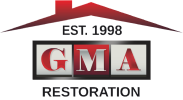Storms can cause significant damage to your roof, and identifying the signs of trouble early can save you from costly repairs down the line. At GMA Restoration, we specialize in commercial and residential roofing, including storm damage roofing, and we know how critical it is to act quickly after severe weather hits. Here’s a step-by-step guide on how to spot roof damage after a storm and when to call in the professionals.
1. Inspect the Interior of Your Home or Business
Your first step in checking for roof damage should start inside your property. Often, the signs of roof damage are visible from the interior before you notice them outside.
What to Look For:
- Water Stains on Ceilings and Walls: Brown or yellow discoloration on ceilings or walls is a clear indicator of leaks.
- Dripping Water: If you see water dripping or pooling in your attic or any room, it’s likely due to a compromised roof.
- Mold or Mildew Growth: Moisture from leaks can lead to mold or mildew, which can be harmful to your health and indicate a persistent roof problem.
- Musty Odors: A damp or musty smell in your attic or living spaces can also point to water intrusion from the roof.
2. Check for Missing or Damaged Shingles
After inspecting the interior, move outside to examine the roof itself. Missing or damaged shingles are among the most common signs of storm damage.
What to Look For:
- Missing Shingles: Storms with high winds can easily blow shingles off your roof, leaving underlying materials exposed.
- Cracked or Curled Shingles: Even if shingles are still in place, they may be cracked, curled, or otherwise damaged.
- Granule Loss: Check your gutters and the base of your downspouts for granules. A significant amount of granule loss can weaken shingles and shorten their lifespan.
3. Examine Flashing and Vents
Flashing and vents are critical components of your roof, designed to protect vulnerable areas from water intrusion. Storms can easily damage these areas, leading to leaks and structural issues.
What to Look For:
- Loose or Bent Flashing: Flashing around chimneys, vents, and skylights should be securely fastened. Look for signs that it has been bent, lifted, or otherwise compromised.
- Damaged Vents: Roof vents should be checked for cracks, dents, or missing components that could allow water to seep in.
- Rust or Corrosion: Metal flashing and vents that are rusted or corroded are more likely to fail during a storm.
4. Inspect Gutters and Downspouts
Gutters and downspouts play a crucial role in directing water away from your roof and foundation. If they’re damaged or clogged, they can cause water to back up and damage your roof.
What to Look For:
- Detached or Sagging Gutters: Gutters should be securely attached to the roofline. If they’re sagging or have pulled away, they may have been damaged by the storm.
- Clogs or Blockages: Debris from the storm can clog gutters and downspouts, preventing proper water drainage.
- Water Stains on Exterior Walls: Stains on the exterior walls of your home or business can indicate that water is overflowing from the gutters and seeping into the building.
5. Look for Signs of Structural Damage
Strong storms can cause significant structural damage to your roof, which may not always be immediately visible.
What to Look For:
- Sagging Rooflines: A sagging roofline is a serious indicator of structural damage and requires immediate attention.
- Visible Gaps or Cracks: Check for any gaps, cracks, or separations in the roofing materials, especially near joints and edges.
- Loose or Missing Roof Supports: In more severe cases, you may notice that roof supports or framing have shifted or are missing entirely.
6. Check for Debris and Other Hazards
Storms often leave behind debris that can further damage your roof if not removed promptly.
What to Look For:
- Branches and Leaves: Large branches or heavy debris can puncture your roof, while smaller debris can clog gutters and cause water backup.
- Hail Damage: If your area experienced hail, inspect your roof for dents or dings, especially on metal surfaces like flashing or vents.
- Punctures and Holes: Sharp debris can create punctures or holes in your roofing material, leading to leaks and further damage.
7. Know When to Call a Professional
While some minor issues can be addressed with DIY fixes, many types of storm damage require the expertise of a professional roofing company. Attempting to repair significant damage on your own can lead to further problems and may void your roof’s warranty.
When to Call GMA Restoration:
- Widespread Damage: If you notice multiple areas of concern, it’s best to have a professional assess the full extent of the damage.
- Structural Concerns: Any signs of structural damage, such as a sagging roofline, should be evaluated by a roofing expert immediately.
- Safety Risks: If there are hazards like downed power lines, large debris, or extensive damage, leave the inspection to professionals who have the right equipment and training.
Conclusion
Spotting roof damage after a storm is crucial to maintaining the integrity of your home or business. By following these steps, you can identify potential issues early and prevent costly repairs down the line. At GMA Restoration, we specialize in storm damage roofing for both commercial and residential properties. If you suspect your roof has been damaged in a storm, don’t hesitate to call (979) 446-2821. Our experienced team is here to provide expert inspections, repairs, and peace of mind. Protect your investment—call GMA Restoration today!
